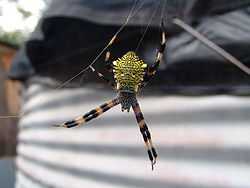Argiope appensa
| Argiope appensa | |
|---|---|
 | |
| A. appensa on Hawai'i | |
| Scientific classification | |
| Kingdom: | Animalia |
| Phylum: | Arthropoda |
| Class: | Arachnida |
| Order: | Araneae |
| Suborder: | Araneomorphae |
| Family: | Araneidae |
| Genus: | Argiope |
| Species: | A. appensa |
| Binomial name | |
| Argiope appensa (Walckenaer, 1842) | |
| Synonyms | |
|
Epeira appensa | |
Argiope appensa is a spider that occurs on several islands in the Western Pacific Ocean. It has been introduced to Hawai'i, and is found on Taiwan and New Guinea. It inhabits a wide variety of habitats, from coasts to forests.
Description
Females reach a body length of up to 7 cm and are strikingly black and yellow, while the brown males reach only about 2 cm.
In Hawai'i they are referred to as Hawaiian garden spiders.[1] In Hawai'i, they are known to be quite communal (see picture), with multi-generational specimens living within close quarters, using the same anchor lines for separate webs. The picture to the left shows one small commune with at least 15 spiders and 8 eggsacs.
On Guam, where Argipoe appensa is ubiquitous, it is frequently visited by Argyrodes argentatus. Locals there refer to them as banana spiders. Following the introduction of the brown tree snake and the subsequent extinction or near-extinction of many of the island's small birds, spider populations on Guam exploded in response to decreasing predation and competition. Nature writer David Quammen has called Argiope appensa "almost certainly one of the larger species" which were encountered in vast numbers during his research trip to Guam for the book The Song of the Dodo.
In popular culture
This species was used in episode "Exposé" of the Lost TV series, which was filmed on location in Hawai'i. It is there named Latrodectus regina (or Medusa Spider), a fictional species of widow spider, in the family Theridiidae. The "males" that run for the female are also females, as the males are much smaller.
Gallery
-
Mature female Argiope appensa being handled in Hilo, Hawai'i
-

Mature female (ventral view) and male (dorsal)
-

Side view of female A. appensa
-

Female in Kuau'i Jungle, Hawaii
References
- Walckenaer, C.A. (1842): Histoire naturelle des Insects. Aptères. Paris, 2: 1-549.
- Kerr, A. M. (1993): Unusually low frequency of stabilimenta in webs of Argiope appensa (Araneae: Araneidae) from the Mariana Islands: an indirect effect of an introduced avian predator? Pacific Science 47: 328-337. Abstract
- Kerr, A.M. (2005): Behavior of web-invading spiders Argyrodes argentatus (Theridiidae) in Argiope appensa (Araneidae) host webs in Guam. Journal of Arachnology 33(1): Abstract PDF
- ↑ Argiope apensa at BugGuide.net
External links
| Wikimedia Commons has media related to Argiope appensa. |
